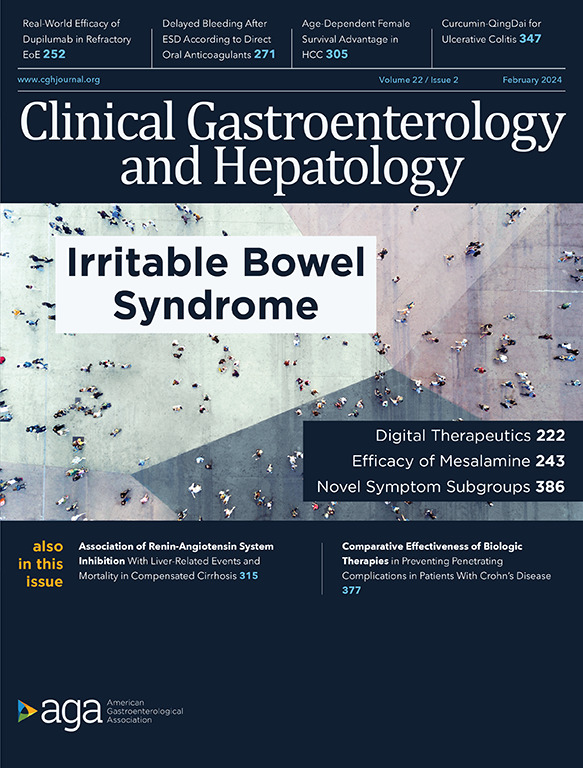慢性乙型肝炎病毒感染功能性治愈的预测因素 - 一项长期随访研究。
IF 11.6
1区 医学
Q1 GASTROENTEROLOGY & HEPATOLOGY
引用次数: 0
摘要
背景与目的:功能性治愈是治疗慢性乙型肝炎病毒(HBV)感染患者的重要终点。我们评估了乙型肝炎 e 抗原(HBeAg)血清学转换后慢性乙型肝炎病毒感染患者功能性治愈的累积概率和预测因素:我们对 413 例(男 249 例,女 164 例)最初 HBeAg 阳性的慢性 HBV 感染者进行了回顾性分析,平均随访 26.36 ± 0.53 年。所有患者在随访期间都进行了 HBeAg 血清转换。功能性治愈的定义是在未接受抗病毒治疗 24 周以上的情况下,HBsAg 和 HBV DNA 持续下降:经过 10888 人年的随访,功能性治愈的累积概率为 14.53%(n = 60)。其中 24 例(40%)患者在接受抗病毒治疗后功能治愈。年功能性治愈率为 0.55%/人-年,HBeAg 血清转换后增加到 0.96%/人-年。在功能性治愈的受试者中,HBeAg 血清学转换后的 HBsAg 和 HBV DNA 滴度与功能性治愈的时间呈正相关(P 分别为 < .001 和 < .001)。对队列进行的多变量 Cox 比例危险分析显示,HBeAg 血清学转换年龄小于 18 岁、HBeAg 血清学转换前接受高遗传屏障核苷类似物治疗以及 HBeAg 血清学转换后 18 个月时血清 HBsAg 滴度小于 1,000 IU/mL 是功能性治愈的重要预测因素(P 分别小于 .001、.001 和 .001):在长期随访的慢性 HBV 感染者队列中,儿童期 HBeAg 血清学转换、高遗传屏障核苷(t)类似物治疗和 HBeAg 血清学转换后的低 HBsAg 滴度是功能性治愈的重要预测因素。本文章由计算机程序翻译,如有差异,请以英文原文为准。
Predictors of Functional Cure of Chronic Hepatitis B Virus Infection: A Long-Term Follow-Up Study
Background & Aims
A functional cure is an essential endpoint in the management of patients with chronic hepatitis B virus (HBV) infection. We evaluated the cumulative probability and predictors of functional cure in patients with chronic HBV infection after hepatitis B e antigen (HBeAg) seroconversion.
Methods
We retrospectively analyzed 413 (249 males and 164 females) initially HBeAg-positive chronic HBV–infected patients who were followed up for a mean of 26.36 ± 0.53 years. All underwent HBeAg seroconversion during follow-up. A functional cure was defined as durable HBsAg and HBV DNA loss without antiviral treatment for more than 24 weeks.
Results
After 10,888 person-years of follow-up, the cumulative probability of functional cure was 14.53% (n = 60). There were 24 (40%) subjects with functional cure after antiviral therapy. The annual functional cure rate was 0.55% per person-year, and increased to 0.96% per person-year after HBeAg seroconversion. In subjects with functional cure, the HBsAg and HBV DNA titers after HBeAg seroconversion were positively correlated with the time to functional cure (P < .001 and < .001, respectively). Multivariate Cox proportional hazards analysis of the cohort revealed that HBeAg seroconversion at <18 years of age, high-genetic-barrier nucleos(t)ide analogue(s) therapy before HBeAg seroconversion, and a serum HBsAg titer <1000 IU/mL at 18 months after HBeAg seroconversion were significant predictors of functional cure (P < .001, .001, and .001, respectively).
Conclusions
In a cohort of chronic HBV–infected patients with long-term follow-up, HBeAg seroconversion in childhood, high-genetic-barrier nucleos(t)ide analogue(s) therapy, and low HBsAg titers after HBeAg seroconversion were significant predictors of functional cure.
求助全文
通过发布文献求助,成功后即可免费获取论文全文。
去求助
来源期刊
CiteScore
16.90
自引率
4.80%
发文量
903
审稿时长
22 days
期刊介绍:
Clinical Gastroenterology and Hepatology (CGH) is dedicated to offering readers a comprehensive exploration of themes in clinical gastroenterology and hepatology. Encompassing diagnostic, endoscopic, interventional, and therapeutic advances, the journal covers areas such as cancer, inflammatory diseases, functional gastrointestinal disorders, nutrition, absorption, and secretion.
As a peer-reviewed publication, CGH features original articles and scholarly reviews, ensuring immediate relevance to the practice of gastroenterology and hepatology. Beyond peer-reviewed content, the journal includes invited key reviews and articles on endoscopy/practice-based technology, health-care policy, and practice management. Multimedia elements, including images, video abstracts, and podcasts, enhance the reader's experience. CGH remains actively engaged with its audience through updates and commentary shared via platforms such as Facebook and Twitter.

 求助内容:
求助内容: 应助结果提醒方式:
应助结果提醒方式:


